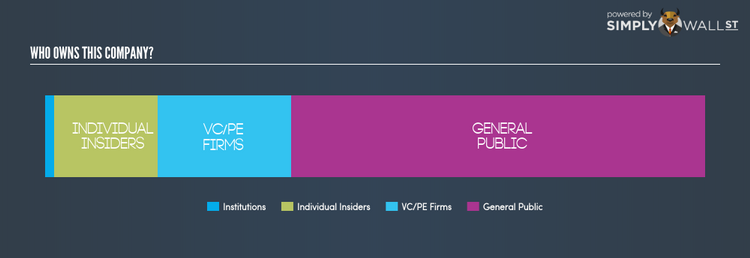Who Owns Pluralsight Inc (NASDAQ:PS)?

In this article, I’m going to take a look at Pluralsight Inc’s (NASDAQ:PS) latest ownership structure, a non-fundamental factor which is important, but remains a less discussed subject among investors. When it comes to ownership structure of a company, the impact has been observed in both the long-and short-term performance of shares. Since the same amount of capital coming from an activist institution and a passive mutual fund has different implications on corporate governance, it is a useful exercise to deconstruct PS’s shareholder registry.
See our latest analysis for Pluralsight
Institutional Ownership
Institutional investors are one of the largest group of market participants and their buy-sell decisions on a company’s stock can significantly impact prices, more so, when there are relatively small amounts of shares available on the market to trade. With hardly any institutional ownership, PS stock poses limited concern relating to the effect institutional block trades have on its stock price.
Insider Ownership
Another important group of shareholders are company insiders. Insider ownership has to do more with how the company is managed and less to do with the direct impact of the magnitude of shares trading on the market. With 7.32% ownership, PS insiders is an important ownership type. An insider stake of this level indicates that executives are highly aligned with the shareholders as both stand to gain when the value of the company rises. However, it would be interesting to take a look at their buying and selling activities lately. Buying may be sign of upbeat future expectations, but selling doesn’t necessarily mean the opposite as the insiders may be motivated by financial needs or they are simply diversifying their risk.
General Public Ownership
The general public holds a substantial 29.15% stake in PS, making it a highly popular stock among retail investors. This size of ownership gives retail investors collective power in deciding on major policy decisions such as executive compensation, appointment of directors and acquisitions of businesses. This level of ownership gives retail investors the power to sway key policy decisions such as board composition, executive compensation, and potential acquisitions. This is a positive sign for an investor who wants to be involved in key decision-making of the company.
Private Equity Ownership
With a stake of 9.42%, private equity firms form another important class of owners in PS. With a stake of 9.42%, they can influence PS’s key policy decisions. An investor should be encouraged by the ownership of these institutions who are known to be experts in increasing efficiency, improving capital structure and opting for value-accretive policy decisions.
Next Steps:
With a low level of institutional ownership, investors in PS need not worry about non-fundamental factors such as ownership structure causing large impact on stock prices. However, if you are building an investment case for PS, ownership structure alone should not dictate your decision to buy or sell the stock. Rather, you should be looking at fundamental drivers such as the intrinsic valuation, which is a key driver of Pluralsight’s share price. I urge you to complete your research by taking a look at the following:
Financial Health: Is PS’s operations financially sustainable? Balance sheets can be hard to analyze, which is why we’ve done it for you. Check out our financial health checks here.
Valuation: What is PS worth today? Is the stock undervalued, even when its growth outlook is factored into its intrinsic value? The intrinsic value infographic in our free research report helps visualize whether PS is currently mispriced by the market.
Other High-Performing Stocks: Are there other stocks that provide better prospects with proven track records? Explore our free list of these great stocks here.
NB: Figures in this article are calculated using data from the last twelve months, which refer to the 12-month period ending on the last date of the month the financial statement is dated. This may not be consistent with full year annual report figures.
To help readers see pass the short term volatility of the financial market, we aim to bring you a long-term focused research analysis purely driven by fundamental data. Note that our analysis does not factor in the latest price sensitive company announcements.
The author is an independent contributor and at the time of publication had no position in the stocks mentioned.

